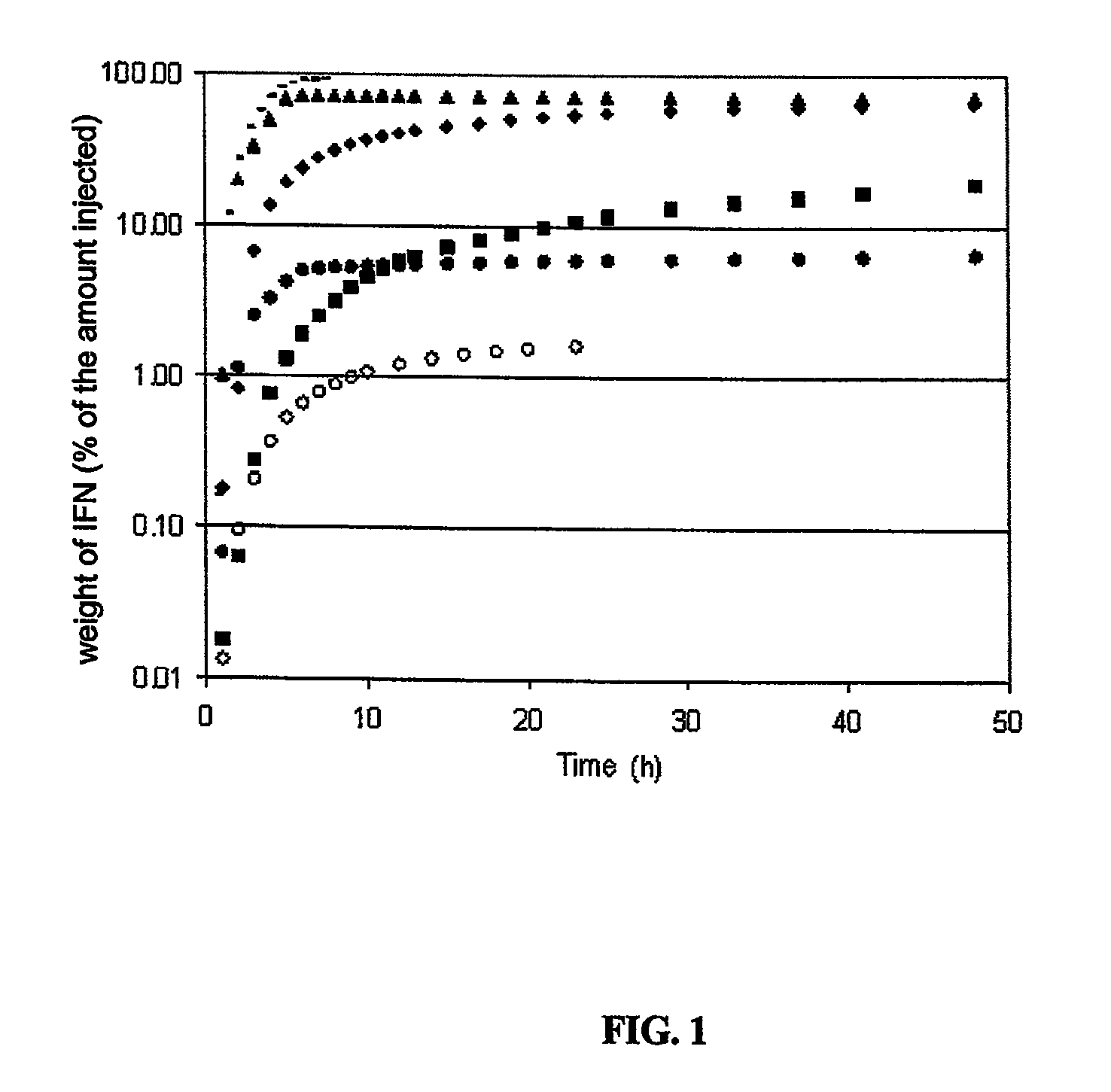Modified-release particles of polyelectrolytes and pharmaceutical formulations thereof
a technology of polyelectrolytes and modified release particles, which is applied in the direction of powder delivery, peptides, microcapsules, etc., can solve the problems of repeated injections, serious long-term side effects, and significant harmful effects of high-toxicity therapeutic proteins such as cytokines, and achieves the effect of easy redigestion
- Summary
- Abstract
- Description
- Claims
- Application Information
AI Technical Summary
Benefits of technology
Problems solved by technology
Method used
Image
Examples
example 1
2) Example 1
(Comparative): Preparation of Particles with Polyelectrolytes not Exhibiting a Hydrophobic Group
[0250](1) Preparation of a colloidal solution of polymer PE1-B:
[0251]The polymer PE1-B obtained according to synthesis b) above is used. This polymer has a half-neutralization pH equal to 5.985.
[0252]A colloidal solution of polymer PE1-B is obtained by dissolving it in water, the pH being adjusted to 7.63 by addition of a NaOH solution. The osmolarity of the solution is adjusted to 100 mOsm by introducing the necessary amount of an aqueous NaCl solution. The concentration of polymer PE1-B is adjusted to 8.38 mg / g.
(2) Association of the Protein with the Polymer Pe1-B:
[0253]2.4 mg / g concentrated protein IFN-α (PC GEN) is added to the preceding colloidal solution of polymer PE1-B. The association having the following characteristics is obtained:
[PE1-B] (mg / g)[IFN-α] (mg / g)pH4.551.17.17
The association is produced overnight at 25° C. with stirring.
(3) Preparation of a Colloidal Sol...
example 2
3) Example 2
Preparation of Particles with a Single Polyelectrolyte (PE1) Exhibiting Hydrophobic Groups
[0261](1) Preparation of a Colloidal Solution of Polymer PE1-A:
[0262]The polymer PE1-A obtained according to synthesis a) above is used. This polymer has a half-neutralization pH equal to 5.445.
[0263]A colloidal solution of polymer PE1-A is obtained by dissolving it in water, the pH being adjusted to 7.53 by addition of a NaOH solution. The osmolarity of the solution is adjusted to 101 mOsm by introducing the necessary amount of an aqueous NaCl solution. The concentration of polymer PE1-B is adjusted to 8.41 mg / g.
[0264](2) Association of the Protein with the Polymer PE1-A:
[0265]2.4 mg / g concentrated protein IFN-α is added to the preceding colloidal solution of polymer PE1-A. The association having the following characteristics is obtained:
[PE1-A] (mg / g)[IFN-α] (mg / g)pH4.581.17.17
[0266]The association is produced overnight at 25° C. with stirring.
[0267](3) Preparation of a Colloidal ...
example 3
4) Example 3
Preparation of Particles Based on PE1-A and on PE2-A, Comprising IFN-α
4.1) Example 3.1
Final Concentration of Polymer Approximately Equal to 10 mg / g, Z being Equal to Approximately 1
[0277](1) Preparation of a Colloidal Solution of Polymer PE1-A:
[0278]The polymer PE1-A obtained according to synthesis a) above is used. This polymer has a half-neutralization pH equal to 5.445.
[0279]A colloidal solution of polymer PE1-A is obtained by dissolving it in water, the pH being adjusted to 7.45 by addition of a NaOH solution. The osmolarity of the solution is adjusted to 108 mOsm by introducing the necessary amount of an aqueous NaCl solution. The concentration of polymer PE1 is adjusted to 23.88 mg / g.
[0280](2) Association of the Protein with the Polymer PE1-A:
[0281]2.4 mg / g concentrated protein IFN-α and 89 mOsm NaCl are added to the preceding colloidal solution of polymer PE1-A. The association having the following characteristics is obtained:
[PE1-A] (mg / g)[IFN-α] (mg / g)pHOsmolari...
PUM
| Property | Measurement | Unit |
|---|---|---|
| pH | aaaaa | aaaaa |
| size | aaaaa | aaaaa |
| size | aaaaa | aaaaa |
Abstract
Description
Claims
Application Information
 Login to View More
Login to View More - R&D
- Intellectual Property
- Life Sciences
- Materials
- Tech Scout
- Unparalleled Data Quality
- Higher Quality Content
- 60% Fewer Hallucinations
Browse by: Latest US Patents, China's latest patents, Technical Efficacy Thesaurus, Application Domain, Technology Topic, Popular Technical Reports.
© 2025 PatSnap. All rights reserved.Legal|Privacy policy|Modern Slavery Act Transparency Statement|Sitemap|About US| Contact US: help@patsnap.com



